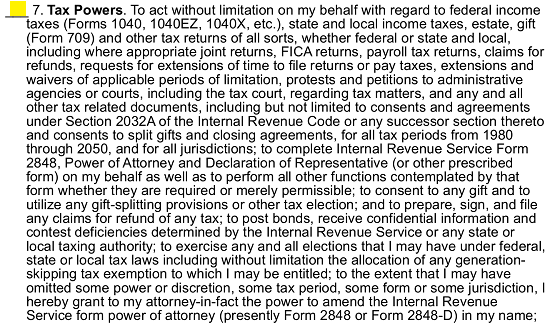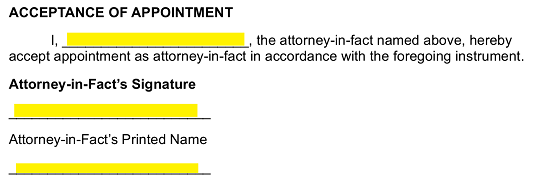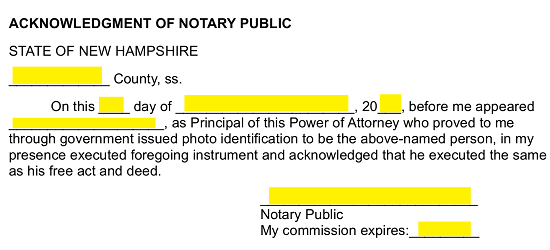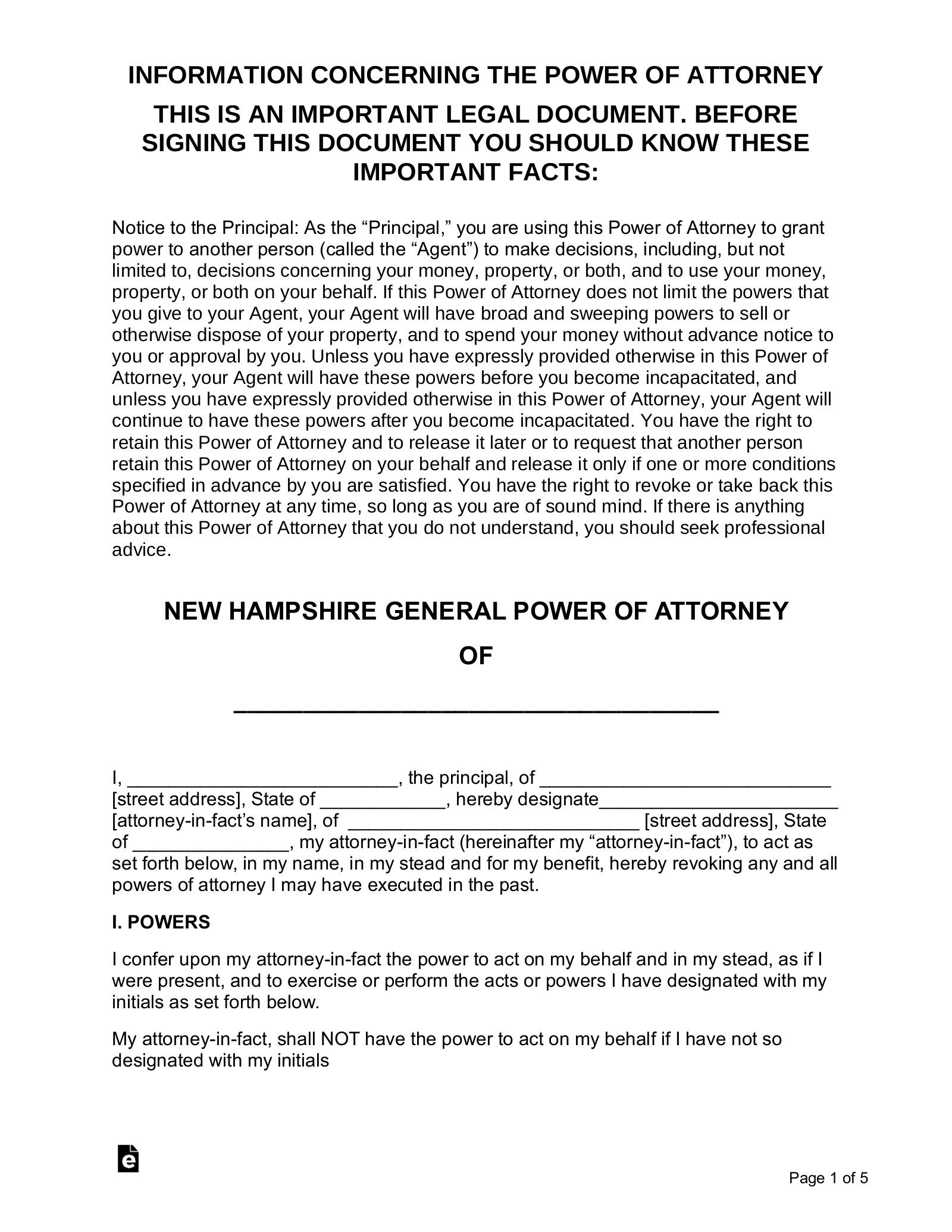Updated August 09, 2023
A New Hampshire general (financial) power of attorney form allows you to designate an individual (i.e. friend, relative, appropriate professional) to manage your finances in your name. This agent will be able to act on your behalf in the matters you define here once you provide the required signature approval. You, as the principal, will need to go through the articles in this document and choose which types of powers the agent should be allowed to wield, when this document will become effective, and when it will terminate. Both parties must read every part of the finished product as it will contain details on the responsibilities each one must fulfill in a lawful manner.
Your agent will have the power to act on your behalf until you revoke this paperwork or become incapacitated. If you are found to be unable to make your own decisions, this POA terminates. This is unlike the New Hampshire Power Of Attorney, where the agent is able to continue acting under the POA even when the principal is incapacitated. The form should comply with RSA 506:6.
Laws
- Statutes – Chapter 564-E: Uniform Power of Attorney Act
- Authority (N.H. Rev. Stat. § 564-E:201) – An agent under a power of attorney may act on behalf of the principal and exercise broad authority as granted by the agreement.
- Signing Requirements (N.H. Rev. Stat. § 564-E:105) – The principal must have their signature acknowledged in the presence of a notary public.
How to Write
Download: PDF, MS Word, OpenDocument
1 – Identify The Individuals Acting As Principal And Agent
Look for the blank line in the Title on the first page then, enter the Principal’s First, Middle, and Last Name. 
The blank line in the first paragraph must also have the First, Middle, and Last Name of the Principal presented. Make sure the Name is recorded exactly as you have entered it in the Title.
Use the second blank space to enter the Building Number, Street, Unit Number, City, and Zip Code of the Principal’s Residential Address. You must continue this report by recording the State where the Principal lives on the third blank space.
The last three spaces of this paragraph will be devoted to presenting the Attorney-in-Fact’s information. Find the phrase “…Hereby Designate” then fill in the Attorney-in-Fact’s First Name, Middle Name, and Last Name on the blank space following it.
Use the next blank line to fill in the Attorney-in-Fact’s Home Street Address. This should contain the Building Number, Street Name, Unit Number, City, and Zip Code where the Attorney-in-Fact is physically located.
Document the State where the Attorney-in-Fact lives on the last blank line of this declaration statement.
2 – Principal Approval Must Be Provided Directly By The Principal
This document provides a list of Power Descriptions that could or could not apply to the Attorney-in-Fact’s Principal Power to make decisions and take action on behalf of the Principal. Only the statements that bear the Principal’s initials will contain Power Descriptions of what the Attorney-in-Fact may do on behalf of the Principal. Statements that have not been initialed by the Principal will describe actions the Attorney-in-Fact may not take unless another it is through a document issued in the future.
Look for the first statement. It will be easily located by finding the bold phrase “1. Power To Make Payments Or Collect Monies Owed.” The Principal can appoint the Attorney-in-Fact with the Authority collect, make, or negotiate Payments whether they are to or from the Principal by initialing this statement.
The second statement will assign the Attorney-in-Fact will appoint the Attorney-in-Fact with the Principal Authority to Acquire, Lease, or Sell Personal Property in his or her Name when it is initialed by the Principal.
If the Principal would like to appoint the Attorney-in-Fact with the Power to Acquire, Lease, or Sell the Principal’s Real Property as if he or she were the Principal, the second statement will need to be initialed by the Principal.
The Attorney-in-Fact will be allowed to utilize Principal Management Powers if the Principal initials the fourth statement.
If the fifth paragraph in this list is initialed by the Principal, he or she will grant “Banking Powers” to the Attorney-in-Fact, thereby approving the Attorney-in-Fact’s use of Principal Power with Financial Institutions.
The sixth paragraph will assign the Attorney-in-Fact with the Principal Authority to deal with agencies, businesses, and individuals regarding Motor Vehicles as if he or she were the Principal. If the Principal initials the blank space preceding the number 6, the Attorney-in-Fact will be able to carry out all of the actions described in the paragraph.
The Power to represent the Principal when it comes to his or her Taxes will be defined in paragraph 7. If the Principal wishes the Attorney-in-Fact to represent him or her in Tax Matters then he or she will need to initial the seventh paragraph.
The Attorney-in-Fact will be given access and control to and over the principal’s Safe Deposit Boxes if the Principal initials the eighth statement in this list.
The Gift Making Powers the Principal has can be appointed to the Attorney-in-Fact through the Principal act of initialing item 9.
The tenth paragraph will grant the Attorney-in-Fact with the Principal Power to engage of “Lending And Borrowing” on behalf of the Principal if the Principal initials the blank line preceding it
If the Principal wishes to grant the Attorney-in-Fact with the Power to represent him or her regarding “Contracts,” he or she should initial the eleventh statement.![]()
The twelfth statement will define the Health Care Principal Powers that may be delivered to the Attorney-in-Fact in regards to the Principal. If the Principal would like to appoint the Attorney-in-Fact with the Principal Authority to behave in this way, he or she should initial the eleventh statement.
The thirteenth paragraph will name the Attorney-in-Fact with the Principal Representational Powers as defined by the Health Insurance Portability And Accountability Act of 1996 if the Principal initials the blank space provided.
The Principal can use the fourteenth statement to approve the Attorney-in-Fact’s Principal Power to Hire and Pay For Services on behalf of the Principal by initialing the blank line preceding the number 14.
If the Principal wishes to grant the Attorney-in-Fact with the Authority to ensure Reimbursement of the Attorney-in-Fact then, he or she should initial the blank line preceding paragraph 15.![]()
The Principal will grant the Attorney-in-Fact with the Principal Power to Sue Third Parties on his or her behalf to enforce this document, he or she will need to initial the sixteenth item.

The final item on this list is labeled simply “Other.” Here the Principal may have direct instructions or provisions included on this document. The Principal can insist on limitations or restrictions, provide extensions, or discuss preferences at his or her discretion on the blank lines provided. If this item is used, the Principal must initial the blank space preceding the number 17.
3 – This Document Must Have A Defined Life Span
The third section of this appointment form will present a method to clearly define the Principal’s expectations regarding when the Attorney-in-Fact may begin to use Principal Authority and when the Attorney-in-Fact must stop using Principal Authority. This section will provide two distinct areas. In the first one, we will define when the Attorney-in-Fact may begin utilizing Principal Authority on behalf of the Principal.
Locate the first two statements. If the Principal wishes the Powers in this document to be accessible to the Attorney-in-Fact when he or she signs this form, the first statement will need to be initialed by the Principal. If the Principal wishes the Powers here to be accessible only as of a certain date then he or she should initial the second statement then enter the desired Start Date using the two blank lines provided. The Principal can only select one of these first two statements.
Just below the paragraph beginning with the words “To Indicate When This Document Shall Become Terminated…” will be three statements, each providing a method of termination. If the Principal wishes to name the Date of Termination, he or she should initial the first statement in this area then enter the desired Date on the blank spaces provided. If the Principal wishes the documents to remain in effect until he or she issues a Revocation, then he or she must initial the second statement. If the Principal wishes this document’s Appointments of Power to terminate the moment he or she is diagnosed as incapacitated, the third statement will need to be initialed. The Principal may only select one of the last three statements.
4 – The Final Part Of This Document Requires Principal Verification
The Principal should read the section labeled “Third Party Consent” then enter the Date he or she is signing this paperwork. Three spaces in the final statement have been provided for this purpose. The Principal should document the Calendar Day, Calendar Month, and Calendar Year when he or she is signing this document.![]()
Finally, once these tasks have been completed and a final review of the Principal has concluded, he or she should sign and print his or her Name on the blank lines labeled “Principal’s Signature” and “Principal’s Printed Name.”
The next Signature Area is titled “Acceptance Of Appointment.” Here the Attorney-in-Fact’s Full Name should be filled onto the blank line in this paragraph. The Attorney-in-Fact will need to sign then print his or her Name on the blank spaces labeled “Attorney-in-Fact’s Signature” and “Attorney-in-Fact’s Printed Name.” 
The last segment of this paperwork is reserved for the Notary Public notarizing this document’s Principal Signing.


